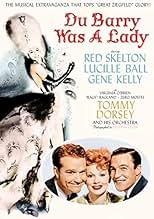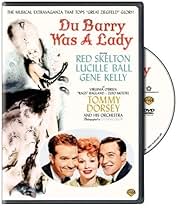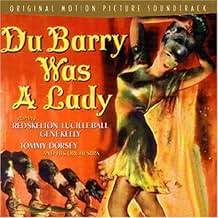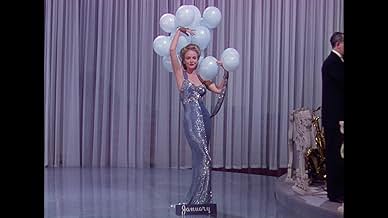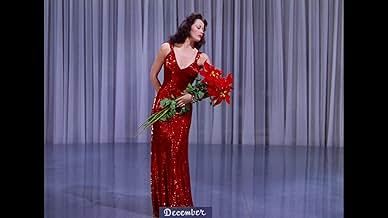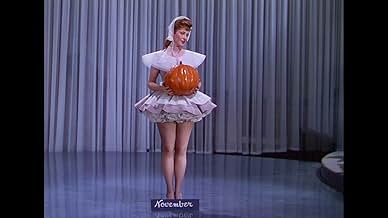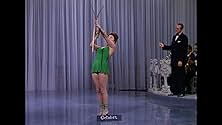AVALIAÇÃO DA IMDb
6,2/10
1,8 mil
SUA AVALIAÇÃO
Um atendente de boate que está apaixonado pela cantora do clube acidentalmente toma uma bebida drogada que o faz sonhar que ele é o rei francês Louis XV, cortejando a infame Madame Du Barry.Um atendente de boate que está apaixonado pela cantora do clube acidentalmente toma uma bebida drogada que o faz sonhar que ele é o rei francês Louis XV, cortejando a infame Madame Du Barry.Um atendente de boate que está apaixonado pela cantora do clube acidentalmente toma uma bebida drogada que o faz sonhar que ele é o rei francês Louis XV, cortejando a infame Madame Du Barry.
- Direção
- Roteiristas
- Artistas
- Prêmios
- 1 vitória no total
Rags Ragland
- Charlie
- (as 'Rags' Ragland)
- …
Richard Ainley
- Marching Rebel Behind King Louis
- (não creditado)
Grace Albertson
- Perfume Girl
- (não creditado)
Kay Aldridge
- Mrs. McGowan
- (não creditado)
Ernie Alexander
- Delivery Man with Flowers
- (não creditado)
Richard Alexander
- Marching Rebel Behind King Louis
- (não creditado)
Avaliações em destaque
The Roy Del Ruth directed romp "Du Barry Was Lady" from 1943 I suggest is one of the most imitated of all cinematic musicals. Its sincere main storyline involving dancer lovestruck Gene Kelly with gorgeous Lucille Ball and funnnyman Red Skelton with Virginia O'Brien is solidly presented. But this Sam Goldwyn style extravagance then blossoms out to include an extended dream-fantasy sequence. The later frenetic pageant stars all the characters in a royal French misadventure with Kelly as a rebel against the corrupt King, Ball as the infamous Du Barry who falls for the handsome "Black Arrow", her chief enemy, and Red Skelton as the dreamer and inept french King Louis XV. The immense cast also includes Rags Ragland, an early Zero Mostel as the Swami, powerful Douglass Dumbrille as Kelly's rival, Donald Meek, George Givot, talented actress Louise Beavers as a lovable but bossy maid, Niagara, and the Tommy Dorsey orchestra with the Pied Pipers, at this time including Dick Haymes and Jo Stafford, plus the Goldwyn Girls. The script for this expensive and lovely musical excuse for two hours' entertainment was supplied from a play by Herbert Fields and Buddy DeSylva, adapted by Nancy Hamilton. the screenplay was provided by Irving Brecher, with additional dialogue by Wilkie Mahoney. If the viewer looks closely, one can perhaps spot Marilyn Maxwell as a Goldwyn Girl, Ava Gardner (somwhere in the background), and fine actors Emory Parnell, Kay Aldridge and Grace Albertson in bit parts. Dorsey's orchestra is given several fine numbers, featuring his many talented sidemen. But the film belongs to the Kelly-Ball mismatch and to Red Skelton, being pursued by O'Brien. The producer was Arthur Freed, who employed Karl Freund's lucid cinematography, memorable art direction of the great Cedric Gibbons, Edmund Willis's elaborate set decorations done with Henry Grace, Gile Steel's male costumes and lovely female counterparts designed by Irene Sharaff, Sydney Guilaroff's difficult hair styles and Jack Dawn's inspired makeup. Music I suggest dominates much of the film; so, mention should be made of the orchestrations by Leo Arnaud and Axel Stordahl, done with George Bassman and music adaptor Roger Edens. Sy Oliver was also involved in orchestrations along with musical director George E. Stoll. Charles Waters is credited with the choreography, including several very fine production numbers. After not having seen the film for many years, I found its theatrical basis only a bit confining--the entire main film takes place in a large nightclub the performances more than adequate and the technicolor of this production absolutely lovely. Ball is much better in the French dream sequence I judge than in the more dramatic central plot; Kelly and Skelton acquit themselves very winningly; and Dumbrille and Mostel dominate every scene they are allowed to play. This can be a most enjoyable film, I suggest, for those in the mood for pure entertainment with a stronger story line than is usual for such 1930s and 1940s extravaganzas staged by Hollywood's studio tsars.
Nightclub singer dreams of marrying into money but is in love with a poor fellow. Fluffy musical comedy plays like a variety show, with minimal plot holding together musical numbers and comedy skits. The film looks good in Technicolor, with red hairs of Skelton and Ball (dyed for this film and kept so thereafter) featured prominently. It's nothing special, but it's not terribly painful to watch either. Lucy mostly plays it straight while Skelton provides the comedy as a hat check man who wins the sweepstakes and woos Lucy. In only his second film, Kelly completes an unlikely love triangle as Lucy's poor and sullen boyfriend.
When MGM bought the rights to Cole Porter's DuBarry Was A Lady for the Arthur Freed unit as per usual the naughty Porter score was completely emasculated and songs old and new from a variety of sources were interpolated into the film. It was like his lyric of Friendship, a perfect blendship.
If you're attentive however you can hear at least two of the songs played as background music, When Love Beckoned and Well Did You Evah which was later interpolated by MGM into High Society for that never to be forgotten duet with Bing Crosby and Frank Sinatra. Only Friendship, Do I Love You Do I and Katie Went To Haiti made the final cut in the score.
Sad also that Ethel Merman and Bert Lahr did not get to repeat the roles they did on Broadway and Darryl Zanuck would not let Betty Grable come over from 20th Century Fox. Ethel only did two of her Broadway roles for the movies, Call Me Madam and Anything Goes and Lahr for whatever reason after the Cowardly Lion from The Wizard Of Oz was given a whole of mediocre parts.
It was said that Merman was not film box office, but certainly Lucille Ball wasn't either at that time. Red Skelton was however, his career was on the rise and so television's two most famous redheads got to team on the big screen.
Lucy is the star of a nightclub chorus and Red is the hat check man who hits the lottery. He's been crushing out on Lucy for forever, but now that he's rich he thinks she might give him a second look. He puts the big moves on her. but she can only see hoofer Gene Kelly. Still his money is tantalizing.
When Red tries to slip Gene a mickey finn he winds up drinking it himself and dreams he's back in the court of Louis XV as Louis XV with Lucy as the notorious Madame DuBarry. And Kelly turns up as the dashing rebel the Black Arrow, rival for the affections of the Madame.
In both the modern and period story MGM packed a lot of entertainment in the 89 minute running time. What court or nightclub would not like to have Tommy Dorsey and his Orchestra as its personal band? There are some nice solos by drummer Buddy Rich and singing with the Pied Pipers are Jo Stafford and newly arrived vocalist Dick Haymes.
Virginia O'Brien contributes a few numbers. She never did any acting roles of note, but was always welcome in an MGM production for her singing and devastating dead pan delivery of a song. Making his big screen debut as the nightclub fortune teller was Zero Mostel with just a trace of his zaniness in play.
This was one of the few films that Gene Kelly was in that he really did not have control of his material yet. Nevertheless his Black Arrow persona was a hint of what you saw later in a high flying dance number in Anchors Aweigh and in The Three Musketeers and The Pirate.
A thin plot is just an excuse to hang a lot of comedy and musical entertainment. But what I would have given to see Merman and Lahr do a faithful adaption on screen.
If you're attentive however you can hear at least two of the songs played as background music, When Love Beckoned and Well Did You Evah which was later interpolated by MGM into High Society for that never to be forgotten duet with Bing Crosby and Frank Sinatra. Only Friendship, Do I Love You Do I and Katie Went To Haiti made the final cut in the score.
Sad also that Ethel Merman and Bert Lahr did not get to repeat the roles they did on Broadway and Darryl Zanuck would not let Betty Grable come over from 20th Century Fox. Ethel only did two of her Broadway roles for the movies, Call Me Madam and Anything Goes and Lahr for whatever reason after the Cowardly Lion from The Wizard Of Oz was given a whole of mediocre parts.
It was said that Merman was not film box office, but certainly Lucille Ball wasn't either at that time. Red Skelton was however, his career was on the rise and so television's two most famous redheads got to team on the big screen.
Lucy is the star of a nightclub chorus and Red is the hat check man who hits the lottery. He's been crushing out on Lucy for forever, but now that he's rich he thinks she might give him a second look. He puts the big moves on her. but she can only see hoofer Gene Kelly. Still his money is tantalizing.
When Red tries to slip Gene a mickey finn he winds up drinking it himself and dreams he's back in the court of Louis XV as Louis XV with Lucy as the notorious Madame DuBarry. And Kelly turns up as the dashing rebel the Black Arrow, rival for the affections of the Madame.
In both the modern and period story MGM packed a lot of entertainment in the 89 minute running time. What court or nightclub would not like to have Tommy Dorsey and his Orchestra as its personal band? There are some nice solos by drummer Buddy Rich and singing with the Pied Pipers are Jo Stafford and newly arrived vocalist Dick Haymes.
Virginia O'Brien contributes a few numbers. She never did any acting roles of note, but was always welcome in an MGM production for her singing and devastating dead pan delivery of a song. Making his big screen debut as the nightclub fortune teller was Zero Mostel with just a trace of his zaniness in play.
This was one of the few films that Gene Kelly was in that he really did not have control of his material yet. Nevertheless his Black Arrow persona was a hint of what you saw later in a high flying dance number in Anchors Aweigh and in The Three Musketeers and The Pirate.
A thin plot is just an excuse to hang a lot of comedy and musical entertainment. But what I would have given to see Merman and Lahr do a faithful adaption on screen.
Now don't get me wrong, `Dubarry Was A Lady' Is not the best Movie Musical I 've ever seen, but it is one of the prettiest. I can't figure out how they where able to achieve such a creamy coloration in the film but the rich pastels used on the sets and costumes are just stunning. There are some wonderful big band numbers with Tommy Dorsey and his orchestra, featuring Dick Haymes. And a campy `Salmome' number by Virginia O'Brien. Gene Kelly looks great and does one nice dance routine, but he mostly sits around mooning over Lucille Ball. Speaking of Lucille Ball, this was her big debut at MGM, and MGM's first full Techincolor musical, and she looks incredible! Her firey red hair and trim figure were perfectly set off by the contemporary costumes, and she looks great in the powdered wigs too!
Give it a look!
Give it a look!
This 1943 Arthur Freed production had a great cast, gorgeous Technicolor, various personalities of the day like Tommy Dorsey (and Dick Haymes and Jo Stafford singing in the flashback sequence), but it's a rather boring film. It's a movie made for a person with the intellect of a fifth grader. I had to stop the film after an hour and watch it the next day to complete it, as my patience had reached its limit for the day. I will say that many musicals of the day had puerile plots, but this one really was on the lower half of the scale.
Lucy and Red, both talented, didn't strike me as all that funny. And Lucy singing with Rita Hayworth's voice double Martha Mears looked and sounded strange. When you're looking for Rita, and you get Lucy, it is quite the shock. I will admit that after checking my facts Martha sang for Lucy before she sang for Rita in Cover Girl one year later, but I still "heard" Rita singing.
Gene was good as always but I couldn't quite see why he wanted Lucy so much. She was beautiful but cold in an icy manner.
Clara "Auntie Em" Blandick had a small bit in a subway which was quite good. And Lana Turner also appears in the film in an uncredited cameo.
Virginia O'Brien, always fun, helped the proceedings as well.
If you're a fan of the MGM musical, you should see it, but it's not a film that will make a list of the top film musicals.
Lucy and Red, both talented, didn't strike me as all that funny. And Lucy singing with Rita Hayworth's voice double Martha Mears looked and sounded strange. When you're looking for Rita, and you get Lucy, it is quite the shock. I will admit that after checking my facts Martha sang for Lucy before she sang for Rita in Cover Girl one year later, but I still "heard" Rita singing.
Gene was good as always but I couldn't quite see why he wanted Lucy so much. She was beautiful but cold in an icy manner.
Clara "Auntie Em" Blandick had a small bit in a subway which was quite good. And Lana Turner also appears in the film in an uncredited cameo.
Virginia O'Brien, always fun, helped the proceedings as well.
If you're a fan of the MGM musical, you should see it, but it's not a film that will make a list of the top film musicals.
Você sabia?
- CuriosidadesMGM hairstylist Sydney Guilaroff dyed Lucille Ball's hair flame red for this film, the color that she kept for the rest of her life and became her trademark.
- Erros de gravaçãoDuring the scene in Madame Du Barry's boudoir when King Louis XV is chasing Du Barry around the dressing table, a man sitting in a chair can be seen reflected in the mirror.
- Cenas durante ou pós-créditosThe Three Oxford Boys are credited orally by the MC ('Gene Kelly') as The Oxford Boys.
- Versões alternativasThis film was published in Italy in an DVD anthology entitled "Cover Girl", distributed by DNA Srl. The film has been re-edited with the contribution of the film history scholar Riccardo Cusin . This version is also available in streaming on some platforms.
- ConexõesEdited into American Masters: Gene Kelly: Anatomy of a Dancer (2002)
- Trilhas sonorasDu Barry Was a Lady
(1943)
Music by Burton Lane
Lyrics by Ralph Freed
Played during the opening credits
Sung by Lucille Ball (dubbed by Martha Mears) and chorus at the nightclub
Principais escolhas
Faça login para avaliar e ver a lista de recomendações personalizadas
Detalhes
- Data de lançamento
- País de origem
- Idioma
- Também conhecido como
- La Dubarry era una dama
- Locações de filme
- Empresa de produção
- Consulte mais créditos da empresa na IMDbPro
Bilheteria
- Orçamento
- US$ 1.239.222 (estimativa)
- Tempo de duração1 hora 41 minutos
- Proporção
- 1.33 : 1
Contribua para esta página
Sugerir uma alteração ou adicionar conteúdo ausente


